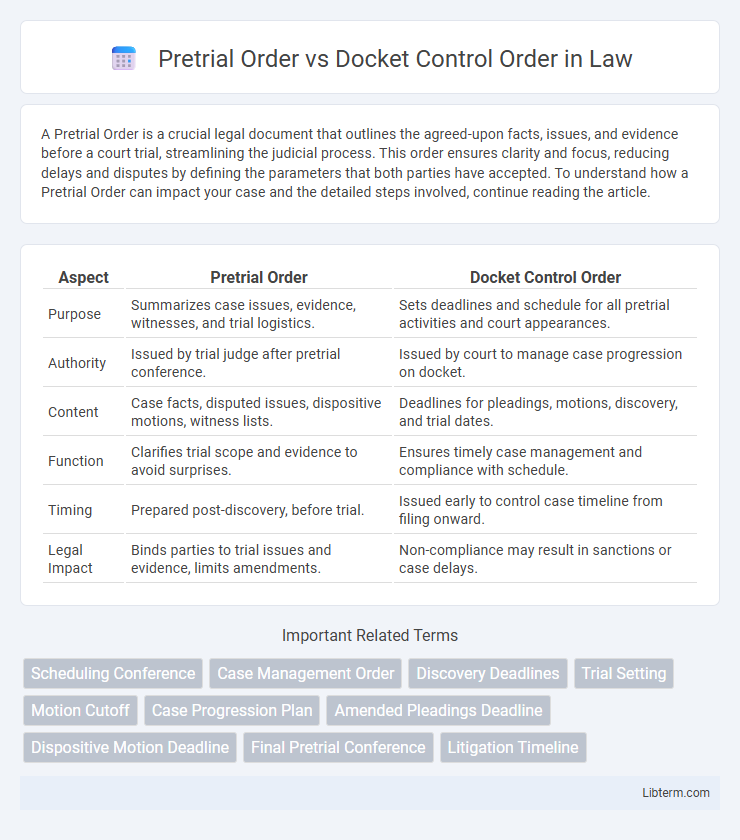A Pretrial Order is a crucial legal document that outlines the agreed-upon facts, issues, and evidence before a court trial, streamlining the judicial process. This order ensures clarity and focus, reducing delays and disputes by defining the parameters that both parties have accepted. To understand how a Pretrial Order can impact your case and the detailed steps involved, continue reading the article.
Table of Comparison
| Aspect | Pretrial Order | Docket Control Order |
|---|---|---|
| Purpose | Summarizes case issues, evidence, witnesses, and trial logistics. | Sets deadlines and schedule for all pretrial activities and court appearances. |
| Authority | Issued by trial judge after pretrial conference. | Issued by court to manage case progression on docket. |
| Content | Case facts, disputed issues, dispositive motions, witness lists. | Deadlines for pleadings, motions, discovery, and trial dates. |
| Function | Clarifies trial scope and evidence to avoid surprises. | Ensures timely case management and compliance with schedule. |
| Timing | Prepared post-discovery, before trial. | Issued early to control case timeline from filing onward. |
| Legal Impact | Binds parties to trial issues and evidence, limits amendments. | Non-compliance may result in sanctions or case delays. |
Introduction to Pretrial Orders and Docket Control Orders
Pretrial orders are court-issued directives that outline the specific steps parties must complete before trial, such as discovery deadlines and motions. Docket control orders manage the overall scheduling and progress of a case, ensuring timely resolution by setting deadlines for hearings and trial dates. Both orders play critical roles in case management by promoting efficiency and reducing delays in the litigation process.
Defining Pretrial Orders: Purpose and Functions
Pretrial Orders serve to streamline the litigation process by outlining the issues to be addressed and setting deadlines for discovery, motions, and other pretrial activities. These orders help courts manage case flow efficiently by clarifying legal and factual matters before trial, reducing delays, and promoting settlement discussions. Unlike Docket Control Orders, Pretrial Orders focus specifically on organizing trial preparation and ensuring all parties comply with procedural requirements leading up to trial.
Understanding Docket Control Orders: An Overview
Docket Control Orders establish a specific timeline for all pretrial activities, ensuring that discovery, motions, and other procedural steps align with the court's schedule. These orders help prevent delays by setting deadlines for completing tasks, thus streamlining case management and facilitating a smoother progression toward trial. Understanding the role of Docket Control Orders is essential for effective litigation planning and compliance with court requirements.
Key Differences Between Pretrial Orders and Docket Control Orders
Pretrial Orders outline the specific issues, evidence, and witness lists to streamline trial preparation, serving as a roadmap for both parties and the court. Docket Control Orders establish deadlines for filing motions, discovery completion, and trial dates, ensuring timely case progression and court scheduling efficiency. The key difference lies in Pretrial Orders focusing on trial content and readiness, while Docket Control Orders manage procedural timelines and case flow.
Legal Authority Governing Pretrial and Docket Control Orders
The legal authority governing pretrial orders primarily stems from Federal Rules of Civil Procedure Rule 16, which empowers courts to establish procedures and schedules to manage the progression of cases and encourage settlement. Docket control orders are rooted in the court's inherent authority and local rules designed to ensure timely case management and adherence to procedural deadlines, preventing undue delays. Both orders serve to streamline litigation but derive their regulatory force from distinct procedural frameworks and judicial discretion.
Timeline and Issuance of Pretrial vs. Docket Control Orders
The Pretrial Order is typically issued shortly before the trial date, outlining the agreed facts, legal issues, and evidentiary matters to streamline the trial process. In contrast, the Docket Control Order is issued early in the litigation timeline, establishing deadlines for key case events, such as discovery and motion filing. This timeline distinction ensures the Docket Control Order manages case progress from the outset, while the Pretrial Order focuses on finalizing trial preparations.
Common Elements Included in Pretrial Orders
Pretrial orders commonly include detailed case summaries, procedural history, and a comprehensive list of agreed-upon facts and disputed issues, which streamline trial preparation. Witness lists, exhibit inventories, and stipulations for evidentiary matters are also essential components, facilitating efficient courtroom management. These elements contrast with docket control orders that primarily focus on scheduling deadlines and case milestones rather than substantive case details.
Core Components of a Docket Control Order
A Docket Control Order establishes a structured timeline for case management, outlining critical deadlines for pleadings, disclosures, discovery, and pretrial motions to ensure efficient progression toward trial. Its core components include specific cut-off dates for filing motions, schedules for expert witness disclosures, and deadlines for completing discovery, which collectively minimize delays and maintain court docket integrity. Unlike a Pretrial Order that summarizes trial preparation, the Docket Control Order provides the procedural framework essential for monitoring case milestones and coordinating judicial resources.
Impact on Case Management and Litigation Strategy
Pretrial Orders establish the scope of issues, evidence, and witnesses to be presented at trial, significantly shaping litigation strategy by defining trial readiness and focus. Docket Control Orders create a timeline for key case events, enhancing case management by enforcing deadlines and ensuring the efficient progression of litigation. Together, these orders streamline trial preparation, reduce delays, and improve overall case efficiency.
Best Practices for Compliance with Court Orders
Pretrial Orders outline the issues, evidence, and witness lists essential for trial preparation, ensuring parties comply with specified deadlines to avoid sanctions or delays. Docket Control Orders establish a timeline for managing case progression, emphasizing adherence to scheduled hearings and procedural steps to maintain court efficiency. Best practices for compliance include regularly reviewing court-issued orders, timely submission of required documents, and proactive communication with the court to address potential scheduling conflicts.
Pretrial Order Infographic

 libterm.com
libterm.com